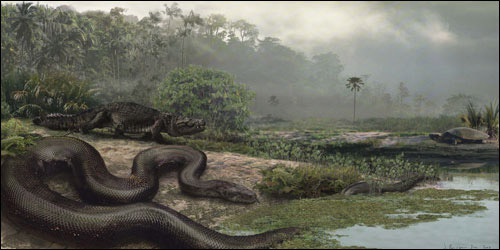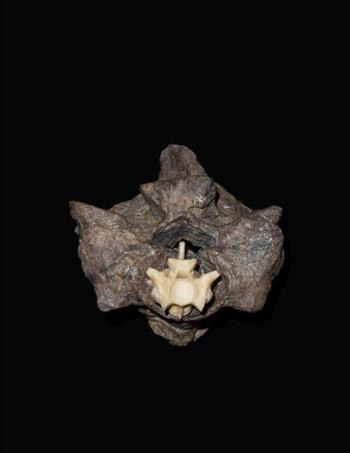Fossil Skeleton of 45-foot long Snake Discovered in South America
With the mass extinction event that marked the end of the Mesozoic, those animals that remained, rapidly diversified and took up most of the ecosystem niches left vacant by the demise of the dinosaurs. Mammals rapidly evolved and diversified and soon all the Orders that we know today were established. However, those reptiles that had outlasted the dinosaurs also took the opportunity to exploit new environments and those places in the food chain left empty by the dinosaurs.
Fossils of one of the largest snakes known to science have just been unearthed in South America, and this new snake named Titanoboa would have probably been the apex predator in its jungle environment.
Titanoboa
The Palaeocene epoch lasted approximately 10 million years (65-55 million years ago). The world slowly recovered from the catastrophes that had led to the extinction of approximately 60% of the life on Earth. Within a few hundred thousand years of the end of the Mesozoic, planet Earth was covered in lush rain-forest, jungle and swamps. Global temperatures rose to an average of 28 degrees Celsius and humidity increased permitting gigantism in creatures as diverse as insects, birds and reptiles.
“Hot House Earth”
Our planet had not experienced such a “hot house” environment since the Jurassic and those types of animals that had survived the extinction event soon found themselves in a lush, warm, humid environment, so warm in fact that tropical rain-forest and jungle stretched from the tips of Chile and South Africa right up to beyond the Canadian border.
European countries such as Germany and Poland had similar climates as did much of China in the east. Even the United Kingdom was covered in tropical rain-forest (hard to believe considering the icy conditions that we have had this week).
With cold-blooded animals such as snakes, the temperature and availability of food can affect the potential size of a species. With such a warm climate, the absence of major predators such as the Theropod dinosaurs, snakes were able to exploit the conditions and truly huge forms began to evolve.
A New Genus of Snake
The fossils of this new genus of snake, believed to be a constrictor like a boa or the giant Anaconda of South America, were found at an open cast mine in north-eastern Columbia. Along with the giant bones of the snake, fossils of crocodiles and turtles were also discovered, perhaps these other reptiles made up a large part of this Titanoboa’s diet.
An Artist’s Impression of Titanoboa

Picture credit: Jason Bourque
Estimating the Size of Titanoboa
Estimating the size of the snake based on comparisons with extant species indicates a length of 15 metres with a weight in excess of 1,200 kilogrammes. Fossils of large snakes have been discovered in South America before. An example would be Madtsoia bai, a huge constrictor known from fossils discovered in Argentina in the mid 1930s. This particular species was believed to be up to 12 metres long, huge by modern snake standards but still 20% smaller than Titanoboa.
Commenting on the new discovery, Jack Conrad a snake expert at the American Museum of Natural History in New York stated:
This thing [Titanoboa] weighs more than a bison and is longer than a city bus. It could easily eat something the size of a cow. A human would just be toast immediately”.
The details of this discovery is published in this week’s edition of the scientific journal “Nature”.
Titanoboa cerrejonensis
The species has been formally named Titanoboa cerrejonensis, the name means “titan boa from the Cerrejon”, the region of Columbia where the snake fossils were found. Although, probably more closely related to boas such as the Royal Python, this snake probably behaved more like an Anaconda, being at home equally well in water and on land.
The Boas (family Boidae), are considered to be relatively primitive in comparison with venomous snakes that make up the order Squamata such as vipers. Scientists believe that snakes such as Boas evolved from lizards during the Late Cretaceous and snakes were constrictors at first, then eventually venomous forms evolved.
Boas retain several features that link them to their lizard ancestors. For example, most species of boa retain a pelvic girdle and traces of the hind-limbs are found in a number of species. The vestigial hind-limbs have been reduced to cloacal spurs in many types of boa, these can be seen on males. Members of the Boidae family also retain the coronoid bone in the lower jaw, another link to their lizard ancestry that has been lost in higher snakes.
Titanoboa can make a claim for being the largest snake known to science. When its fossilised bones are compared to those of a 6 metre Anaconda the true scale of this beast is revealed.
Comparison of Fossilised Titanoboa Vertebra with Extant Anaconda

Picture credit: Nature
Huge Fossil Vertebra
The huge fossil vertebra of Titanoboa dwarfs the vertebra of a modern Anaconda. When alive Titanoboa would have been about as thick as an oil drum, making it a fearsome predator.
The beast was revealed in early 2007 at the University of Florida’s Florida Museum of Natural History in Gainesville. Fossils collected at a huge open-pit coal mine in Colombia were being unpacked by graduate students and they realised that they were unwrapping the fossilised bones of something spectacular. To date the scientists have identified about 180 different bones, mainly vertebrae and costae (rib bones). These remains are believed to represent about a dozen individuals.
It seems that gigantic, fearsome reptiles did not disappear from our planet with the extinction of the dinosaurs. Some types of reptile exploited the Palaeocene environment to evolve into new types of nightmarish creature.
Rebor Replicas
The model manufacturer Rebor has made several replicas of Titanoboa. To view the figures (whilst stocks last): Rebor Replicas and Models.






Leave A Comment